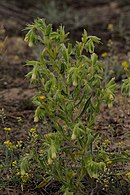Xerothermic relic
Xerothermal relicts ( ancient Greek ξηρός xerós "arid, dry" and ancient Greek θερμός thermós "warm" ) are called populations of plant species in botany and biogeography which are adapted to drought and warmth and which could survive on "warm islands" after climatic changes.
In Central Europe , these include the island-like occurrences of steppe plants . These species were relatively widespread during the last ice age and postglacial warm period when the climate was drier. In today's humid forest climate , they can only be found as relics in naturally forest-free locations where there is no shade. Shallow stone or sandy soils (for example in the Großer Sand nature reserve ) or steep southern slopes are possible. An example of these species from the Pontic flora is the earth sedge ( Carex humilis ).
Examples in Germany
| scientific name | Common name | Occurrence | Biotopes | image |
|---|---|---|---|---|
| Adonis vernalis | Spring Adonis | Central German dry area , Kyffhäuser , NSG Großer Sand , central Oder area | Semi-arid and dry lawns, light oak and pine forests |

|
| Astragalus exscapus | Ground tragacanth | Central German dry area, u. a. in the Lower Saale Valley Nature Park | continental dry and semi-arid grasslands |

|
| Carex humilis | Earth sedge | Central German dry area, low mountain ranges , Alps | Rock corridors, dry u. Semi-arid grassland, pine forests |

|
| Dianthus gratianopolitanus | Peony | National Park basement Edersee , nature reserve Thuringian Slate Mountains / Upper Saale , Swabian Alb | xerothermal limestone and silicate rock crevices, rock corridors |

|
| Fumana procumbens | Ordinary needle rose | Central German dry area, Rhine-Main dry area (e.g. Großer Sand), Dürrenastheide | Limestone corridors and dry grasslands, dry sandy grasslands |

|
| Onosma arenaria | Sand solder root | Large sand (nationwide only occurrence) | continental sand dry grassland, sandy pine dry forests |

|
| Podospermum purpureum | Red salsify | Rhine-Main dry area (e.g. Großer Sand), Kyffhäuser, eastern Brandenburg | Continental dry and semi-arid grasslands |

|
| Seseli annuum | Steppe fennel | Central German dry area, Eifel , Nördlinger Ries , Brilon plateau | Xerothermal lawns, dry shrubbery borders |

|
| Teucrium montanum | Mountain germander | Central German dry area, Saale Valley , Swabian Alb, Alps | Rock and gravel corridors, dry and semi-dry lawns |

|
literature
- Heinrich Walter , Siegmar-W. Breckle: Ecology of the Earth. Volume 3: Special ecology of the temperate and arctic zones of Euro-North Asia. Zonobiom VI – IX (= Ecology of the Earth. Vol. 3; UTB for Science. Large Series. Vol. 8022). G. Fischer, Stuttgart 1986, ISBN 3-437-20310-X , pp. 178-179; 2., revised. Ed. With Mathilde Rahmann, Okmir E. Agachanjanc. G. Fischer, Stuttgart / Jena 1994, ISBN 3-437-20504-8 .
Individual evidence
- ↑ Eckehart J. Jäger (ed.): Rothmaler - Exkursionsflora von Deutschland, vascular plants: basic volume . 21st edition. Springer-Verlag, Berlin Heidelberg 2017, ISBN 3662497077 , see entries for the respective type.
- ↑ a b Eckehart J. Jäger (ed.): Rothmaler - Exkursionsflora von Deutschland, vascular plants: basic volume . 21st edition. Springer-Verlag, Berlin Heidelberg 2017, ISBN 3662497077 , p. 30.
- ↑ Thomas Becker: The steppe relic species Astragalus exscapus - a key species of the steppe remains of Central Europe? scientific publication, University of Trier .
- ↑ The Erd-Sedge: A Cold Age Relic In: Main-Post from March 20, 2012.
- Jump up ↑ Pink flowers on bare rock - For the Whitsun blossom in the Kellerwald-Edersee National Park Website of NABU .
- ↑ Norbert Müller: For the socialization of Fumana procumbens Gr. et Godr. on the Lechfeld near Augsburg scientific report, Office for Environmental Protection and Green Regulations Augsburg.
- ↑ Hessian Ministry for the Environment, Climate Protection, Agriculture and Consumer Protection (ed.): Animals, Plants, Habitats - Guidelines for Implementing Objectives I and II of the Hessian Biodiversity Strategy in the Districts and Urban Cities 2015, p. 29.